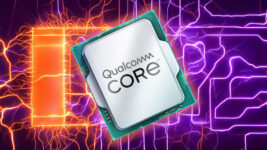
Qualcomm reportedly wants to buy Intel, and Nvidia should be worried
Mobile US chip maker Qualcomm wants to buy Intel, according to the Wall Street Journal. The reported move follows a rapid drop in Intel’s share price after its last quarterly earnings report, which has prompted several cost-saving measures across the company, including large-scale staff layoffs.
Meanwhile, Qualcomm has been making headlines with its latest Snapdragon CPUs. Despite being based on the Arm architecture, its new chips, such as the Qualcomm X Plus range, are able to run the latest Windows software (including games) using on-the-fly x86 emulation. If Qualcomm were to buy Intel, though, it would suddenly be allowed to make full-on x86 chips for the best gaming laptops, while also having access to its Arm expertise, putting it in an enviable position.
After all, Nvidia doesn’t have a license to make x86 CPUs, which is what’s mainly keeping the company out of the best handheld gaming PC space, where AMD is currently dominating. Meanwhile, AMD has dabbled with making Arm chips, but its primary focus has been on making its x86 CPUs and Radeon GPUs. With Intel’s x86 CPU tech under its belt, Qualcomm could make CPUs for a huge range of scenarios.
According to the WSJ report, Qualcomm is looking at a takeover here, rather than a merger, with the piece citing “people familiar with the matter.” These sources reportedly say that Qualcomm has “made a takeover approach to Intel in recent days,” but cautioned that the deal “is far from certain.”
Indeed, bear in mind that none of the above has been officially confirmed by Intel or Qualcomm. This leak is all based on information from anonymous sources right now. Such a deal could have profound consequences on PC gaming if it were to materialize, though.
Both Intel and Qualcomm have made significant strides in their mobile GPU tech recently, with the former even boasting that it now has the best built-in GPU in its Intel Lunar Lake chips. With the licenses and experience to make both Arm and x86 CPUs with this GPU tech, as well as both companies’ NPU hardware, Qualcomm could be the company that can do it all, at least in the laptop and handheld markets.
However, it’s likely that such a takeover would attract the attention of the Federal Trade Commission, as this takeover would join two of the US’ biggest chip makers. As we saw in 2020, a plan for Nvidia to buy Arm for $40 billion fell foul of the UK’s Competition and Markets Authority (CMA), which after investigating said that “the merged business would have the ability and incentive to harm the competitiveness of Nvidia’s rivals by restricting access to Arm’s intellectual property.”
Intel currently has a market value of circa $90 billion, which would make this potentially a bigger financial deal than Nvidia buying Arm, but it has different competitive implications. Many chip manufacturers produce CPUs based on the Arm architecture, including Nvidia, but only a handful of companies produce x86 CPUs, after Intel licensed a small number of companies, including AMD and Cyrix, to produce its chips in the 1970s and 1980s so it could produce enough chips to meet demand. This is why AMD can produce x86 chips for PCs, unlike Nvidia.
For more information about Intel’s current chips, check out our guide to the best gaming CPU, where we take you through all our recommendations right now at a range of prices.



